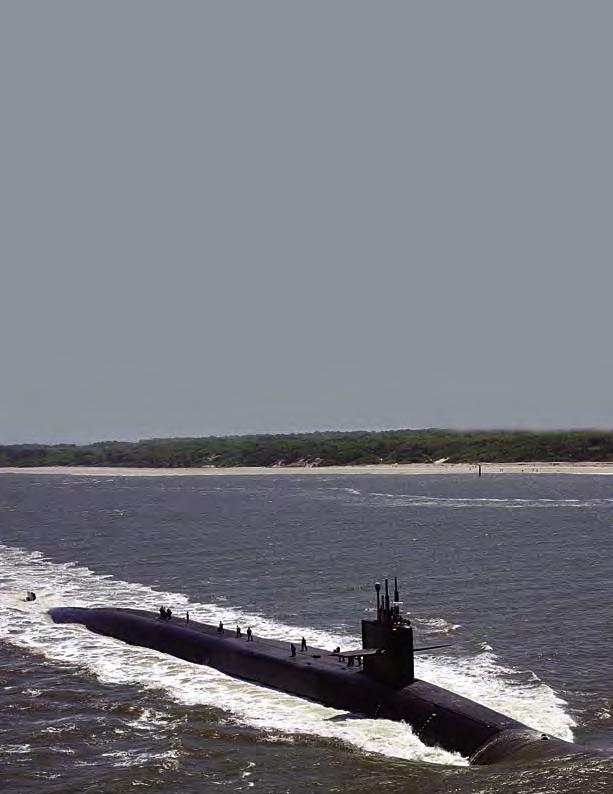
23 minute read
USS Florida Readies for Full Operation
USS USS Florida Readies for Full Operation Florida Readies for Full Operation
The guided-missile submarine USS Florida (SSGN-728) arrived at its new home of Naval Submarine Base Kings Bay, Ga., April 11, after completing the submarine’s threeyear refueling and conversion at Norfolk Naval Shipyard in Portsmouth, Va. Florida is the second Ohio-class ballistic missile submarine the Navy has reconfigured, replacing its 24 TRIDENT missiles with nearly 154 Tomahawk cruise missiles, switching the boat from a nuclear deterrent to a source of more conventional firepower in the global war on terrorism. “We’ve taken the TRIDENT submarine, which is a well proven design, and we’ve done great things with it,” said Florida’s commanding officer, Cmdr. Gregory Ott. “It’s a very flexible platform. We haven’t really built it just for today’s threat. We’ve built it so that it can be modified for whatever’s over the horizon that we can’t imagine.”
Advertisement
Photo by Petty Officer 2nd class Lynn Friant
The Ohio-Class guided missile submarine USS Florida (SSGN-728) makes her way through Cumberland Sound to Naval Submarine Base Kings Bay. Florida is the second of four SSBN submarines to be converted to the guided missile SSGN platform.
The first in the class, the guided-missile submarine USS Ohio (SSGN-726) returned to the fleet in February, and two additional subs, USS Michigan (SSGN727) and USS Georgia (SSGN-729), are currently undergoing conversion.
The Navy’s existing fleet of attack submarines had already been outfitted with Tomahawk cruise missiles, a staple of naval operations in the past used during the early stages of Operation Iraqi Freedom. Although effective, the attack subs could only carry a small number of missiles,
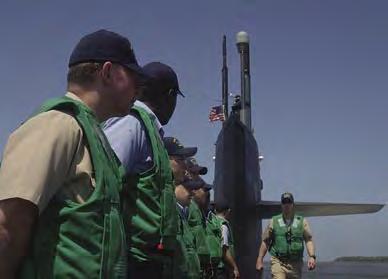
which meant several vessels were needed to conduct major cruise missile strikes.
“When we had submarines in the Gulf,” said Florida’s Chief of the Boat, Command Master Chief (SS) Harold Miller, “it’s a huge waterspace management issue to have multiple submarines in this area. If we had two of the [SSGNs] there, we could have launched more missiles and still not had the waterspace issue that we had.”
Changing to conventional weapons isn’t the only change Florida underwent during the conversion. Several spaces aboard were reconfigured for increased littoral combat capability.
The newly-upgraded SSGNs can now fully house “at least 66 or more SEALs (Sea, Air, Land),” said Ott. “There are no platforms right now other than the SSGN that are dedicated to carrying special forces. And it’s not just the personnel that we can carry – we can carry all of their equipment, and the ship has the capability to deliver the SEALs covertly.”
According to Ott, Florida’s firepower, mixed with a greater capacity to move SEALs and their equipment into mission essential areas, increases the Navy’s ability to engage the enemy on a whole new level.
“The importance of not having anybody know you’re there can’t be overstated,” said Ott. “The bottom line is, if you put a surface ship off the coast or there is knowledge of the Navy’s presence, people don’t do the same things. They go hide when they know you’re there. So, having the submarine there – and that whole stealth piece – is very important.”
The boat was returned to the Fleet in May during a ceremony at Naval Station Mayport in Jacksonville, Fla., and has returned to King’s Bay to begin its service to the Fleet.
Petty Officer 1st Class Rule is assigned to the Fleet Public Affairs Center Atlantic in Norfolk, Va.
(above) Topside line handlers stand in a line as part of the maneuvering watch on board Florida as they approach Naval Submarine Base Kings Bay. Florida departed Norfolk Naval Shipyard headed for her new home port after undergoing a three year conversion from a ballistic to a guided missile submarine.
(right) Florida arrives at Naval Station Norfolk to make a brief stop for passengers during sea trials off the coast of Virginia.
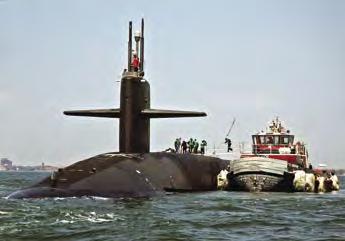
Photo by Chief Petty Officer Dave Fliesen
Community says Farewell to Namesake Submarine USS Honolulu
by Chief Petty Officer (SW/AW) David Rush, USN
U.S. Senator Daniel Inouye, Lieutenant Governor James Aiona, and Commander, Pacific Fleet, Adm. Gary Roughead, joined past and current crewmembers of USS Honolulu (SSN-718) to bid farewell to the nuclear-powered attack submarine at a ceremony on April 15, at Naval Station Pearl Harbor.
Keynote speaker, Seventh Fleet commander Vice Adm. Jonathan Greenert, who commanded Honolulu from 1991 to 1993, said USS Honolulu performed exceptionally well throughout its career. “She was consistently the most reliable ship in the squadron, whatever squadron she was in. Her complex systems always worked well…even the anchor on this ship always worked.”
Inouye said Honolulu, and all other Los Angeles-class submarines, have served the Navy in a variety of roles. “These submarines constituted the front lines during the cold war. Today, they continue to operate…putting SEALs ashore, collecting intelligence, and taking care of our strike forces.”
“USS Honolulu demonstrates how important Pearl Harbor is and how important the submarines are and how much we rely upon them,” Inouye added.
Praising the efforts of her crew that have served for more than 20 years, Aiona cited Honolulu as a valuable asset to the community and the country. “For the past two decades, this nuclear-powered attack submarine has proudly served our nation and her namesake city Honolulu. The state of Hawaii is indeed honored to have had the prestigious USS Honolulu at Pearl Harbor.”
As USS Honolulu’s final operational commanding officer, Cmdr. John Russ said the crew has enjoyed serving and is ready to put the submarine through its paces. “Although we are sad to say goodbye to the best homeport in the Navy – a place that has been a warm and welcoming home for crewmembers and their families for nearly two decades – we are excited about our upcoming deployment,” said Russ. “It’s a chance to put into practice the skills we have spent our careers mastering, and the teamwork we have spent the last few months honing.”
USS Honolulu departed for its final deployment to the Western Pacific in early May. Following the deployment, it will return directly to Bremerton, Wash., to begin inactivation.
Sidney Quintal, director of Enterprise Services for the City & County of Honolulu presented a proclamation on behalf of Mayor
Photo by Chief Petty Officer (SW/AW) David Rush

(above) Honolulu Mayor Mufi Hannemann visited the Pearl Harbor-based Honolulu to bid farewell to the nuclear-powered attack submarine that has served as his city’s namesake for the last two decades. Cmdr. John Russ, USS Honolulu’s commanding officer, exchanged gifts with the Mayor, who was given a tour of the control room, followed by lunch with the crew on the mess deck.
(right) Chief Petty Officer Brian Hircock and Petty Officer 1st Class Burnell Broussard of Honolulu’s navigation department review charts in the control room.
Photo by Petty Officer 2nd Class Corwin Colbert
Mufi Hannemann, who was out of the country. Hannemann visited USS Honolulu on March 29 to bid his farewell.
USS Honolulu has been homeported at Pearl Harbor for most of its operational life. After its commissioning in 1985, it moved to Hawaii to join the Pacific Fleet in September 1986. It has completed nine deployments to the Western Pacific, participated in Operation Enduring Freedom and conducted operations under the Arctic ice.
The submarine has received an impressive array of awards, including six Battle ‘E’s. USS Honolulu is the third ship named in honor of the city of Honolulu, Hawaii.
Photo by Petty Officer 2nd Class Corwin Colbert
USS Honolulu (SSN-718) sails by the USS Arizona Memorial one last time before heading out on its 10th Western Pacific deployment on May 13, 2006. This will be the last deployment for the Pearl Harbor based nuclear-powered attack submarine. Following the deployment, the ship is scheduled for decommissioning and will transit to Bremerton, Wash. to begin inactivation.
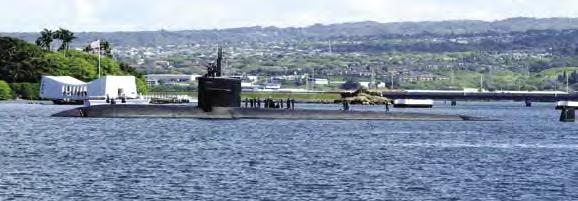
BZ to USS Columbia (SSN-771) for being named the Arleigh Burke Fleet Trophy winner. The award is given annually to the most improved operational unit in the Pacific Fleet.
BZ to USS Memphis (SSN-691) for winning the 2005 Battenberg Cup. The Cup is awarded annually to the best ship or submarine in the Navy’s Atlantic Fleet.
Changes of Command
Submarine Force, U.S. Pacific Fleet Rear Adm. Joe Walsh relieved Rear Adm. Jeffrey Cassias
Director, Submarine Warfare Rear Adm. Carl Mauney relieved Rear Adm. Joe Walsh
Submarine Group EIGHT Rear Adm. Jeffrey Fowler relieved Rear Adm. Carl Mauney
Submarine Learning Center Capt. Richard Moyer relieved Capt. Arnold Lotring
Submarine Squadron FOUR Capt. Richard Breckenridge relieved Capt. Robert Perry
Submarine Development Squadron TWELVE Capt. Kenneth Perry relieved Capt. John Richardson
Submarine Squadron ONE Capt. Stephen Marr relieved Capt. Michael Zieser
Submarine Squadron SEVEN Capt. Jeffrey Powers relieved Capt. Barry Bruner
Submarine Squadron FIFTEEN Capt. Phillip Sawyer relieved Capt. Bradley Gerhke
Submarine Squadron NINETEEN Capt. Kerry Ingalls relieved Capt. Derek Hesse
USS Emory S. Land (AS-39) Capt. Jeffrey Hughes relieved Capt. Michael Budney
NOPF-Whidbey Island, WA Cmdr. Stephen Tripp relieved Cmdr. Laurell Brault
JMF-St. Mawgan, UK Capt. William Stacia relieved Capt. Stephen Noce
USS Pennsylvania (SSBN-735)(B) Cmdr. Brad Neff relieved Cmdr. Michael Dobbs
USS Rhode Island (SSBN-740)(G) Cmdr. Steve Gillespie relieved Cmdr. Peter Clarke USS Annapolis (SSN-760) Cmdr. Dennis McKelvey relieved Cmdr. Donald Neubert
USS Springfield (SSN-761) Cmdr. Paul Savage relieved Cmdr. Peter Miller
USS Connecticut (SSN-22) Cmdr. Daniel Christofferson relieved Cmdr. Philip McLaughlin
USS Miami (SSN-755) Cmdr. Rich Bryant relieved Cmdr. Joe Wiegand
USS Jacksonville (SSN-699) Cmdr. John Kropcho relieved Cmdr. John O’Neil
USS Toledo (SSN-769) Cmdr. Howard Goldman relieved Cmdr. John Schneider
USS Montpelier (SSN-765) Cmdr. Chris Harkins relieved Cmdr. Mark Davis
USS Los Angeles (SSN-688) Cmdr. Erik Burian relieved Cmdr. Thomas Stanley
USS Helena (SSN-725) Cmdr. William Schwalm relieved Cmdr. Douglas Wright
USS Jimmy Carter (SSN-23) Cmdr. Dave Honabach relieved Cmdr. Robert Kelso
USS City of Corpus Christi (SSN-705) Cmdr. Scott Minium relieved Cmdr. Marc Denno
USS Salt Lake City (SSN-716) Cmdr. Eric Irwin relieved Cmdr. Tracy Howard
USS Wyoming (SSBN-742)(G) Cmdr. Roger Isom relieved Cmdr. Eric Merrill
USS Memphis (SSN-691) Cmdr. Glenn Pendrick relieved Cmdr. Bill Merz
USS Columbus (SSN-762) Cmdr. James Doody relieved Cmdr. Charles Marquez
USS Maine (SSBN-741)(B) Cmdr. John Tolliver relieved Cmdr. Robert Palisin
USS Jefferson City (SSN-759) Cmdr. John Zimmerman relieved Cmdr. Daryl Claude
Arco (ARDM-5) Lt. Cmdr. Michael LaPrade relieved Cmdr. Edward Hogan Lt. Cmdr. Travis Petzoldt USS Pennsylvania (SSBN-735)(B)
Lt. Cmdr. Patrick Pfanz USS Alexandria (SSN-757)
Lt. Cmdr. William Solomon III Naval Submarine School
Lt. Cmdr. Donald Tenney COMSUBRON-20
Lt. Cdr. Paul Frontera USS Virginia (SSN-774)
Qualified Nuclear Engineer Officer
Lt. j.g. Richard Arledge USS Louisiana (SSBN-743)(G)
Lt. j.g. John Genta USS Chicago (SSN-721)
Lt. j.g. Theodore Goda USS Salt Lake City (SSN-716)
Lt. j.g. Jeffrey Loebach USS Alaska (SSBN-732)(G)
Lt. j.g. Mathew Merten USS Michigan (SSGN-727)
Line Officers Qualified in Submarines
Lt. Justin Mickolay USS San Juan (SSN-751)
Lt. Theodore Stanton USS Norfolk (SSN-714)
Lt. j.g. David Augustin USS Norfolk (SSN-714)
Lt. j.g. Kevin Beatley USS Newport News (SSN-750)
Lt. j.g. Bradley Bozin USS Newport News (SSN-750)
Lt. j.g. Jonathan Cantor USS West Virginia (SSBN-736)(B)
Lt. j.g. Frank Conlow USS Oklahoma City (SSN-723)
Lt. j.g. Andrew Crawford USS Philadelphia (SSN-690)
Lt. j.g. Samuel Dienes USS Oklahoma City (SSN-723)
Lt. j.g. James Drumgole USS Wyoming (SSBN-742)(B) Lt. j.g. Edan Engstrom USS West Virginia (SSBN-736)(B)
Lt. j.g. Benjamin Frazier USS West Virginia (SSBN-736)(B)
Lt. j.g. Francis Gauthier USS Georgia (SSGN-729)
Lt. j.g. Jamon Holzhouser PCU Texas (SSN-775)
Lt. j.g. Erick Mau USS Wyoming (SSBN-742)(B)
Lt. j.g. Shawn Newburg USS Maryland (SSBN-738)(G)
Lt. j.g. Christopher Newport USS Norfolk (SSN-714)
Lt. j.g. Brian Patterson USS Norfolk (SSN-714)
Lt. j.g. Glenn Richeson USS Wyoming (SSBN-742)(B)
Lt. j.g. Steven Roberts USS Albany (SSN-753)
Lt. j.g. Kevin Shand USS West Virginia (SSBN-736)(B)
Lt. j.g. Andrew Simmons USS Rhode Island (SSBN-740)(B)
Lt. j.g. Adam Sipp USS Wyoming (SSBN-742)(B)
Lt. j.g. Matthew Thelen USS West Virginia (SSBN-736)(B)
Lt. j.g. Aaron Vierbicky USS Scranton (SSN-756)
Supply Corps Officers Qualified in Submarines
Lt. j.g. Jonathan Albano USS Rhode Island (SSBN-740)(B)
Lt. j.g. Matthew Berkau USS Toledo (SSN-769)
Lt. j.g. Jared Sweetser USS Montpelier (SSN-765)
Lt. j.g. Matthew Wilcox USS Maryland (SSBN-738)(B)
Ens. Matthew Miller USS West Virginia (SSBN-736)(B)
Limited Duty Officers Qualified in Submarines
Lt. j.g. Michael Welz USS West Virginia (SSBN-736)(B)
U.S. Navy photo

Rear Adm. Fowler Relieves Rear Adm. Mauney
Rear Adm. Jeffrey Fowler, left, relieves Rear Adm. Carl Mauney as Commander Submarines, Allied Naval Forces South and Commander, Submarine Group EIGHT, during a ceremony held at Nisida, an island off the coast of Naples, Italy. Fowler also relieved as Deputy Commander, Sixth Fleet and Director, Navy Europe Plans and Operations. Mauney relieved Rear Adm. Joe Walsh as Director, Submarine Warfare (OPNAV N87).
USS Boise Conducts Successful First Test of Remote Maintenance Data Retrieval System
by Jack Papp
In a not-too-distant future, deployed U.S. submarines will be able to receive remote troubleshooting and maintenance assistance for their combat systems from technicians ashore in real time.
In a successful first step to making that possible, Lockheed Martin engineers remotely accessed and retrieved classified combat system maintenance data from USS Boise (SSN-764) through a secure SIPRNET landline during a dockside test in March. Boise has the latest installation and software version of the AN/BQQ-10 Submarine Sonar Suite and the AN/BYG-1 Submarine Tactical Combat System.
“We successfully accessed Boise’s combat system, extracted the system’s maintenance data and displayed it ashore at the Norfolk Naval Base Regional Maintenance Center,” said Roger Rosenberger, an engineer involved with the program. “We were able to observe the maintenance data remotely.”
This first step of remotely accessing and retrieving maintenance data was another successful milestone in the Maintenance Free Operating Period (MFOP) initiative. MFOP is a combat system design approach with a goal of eliminating the need for at-sea maintenance, thereby reducing requirements for associated maintenance training, documentation and supply support. With supportability built in – spares are embedded in the system along with the capability to semi-automatically use them in the operational environment – the submarine combat system could be treated as requiring no hardware maintenance actions while on a mission. Consequently the operator’s maintenance actions are reduced to notification and acknowledgement of asset reallocation and software updates/ reconfigurations. System logs provide the necessary information for expeditious dockside maintenance and assistance to eliminate the need for unplanned fly-away technical assist actions.
Previously, Sailors recorded system maintenance data on diskettes aboard the submarine and then sent the data via secure email to Lockheed Martin’s Customer Support Center in Manassas, Va., where it was analyzed by engineers. “What we’ve demonstrated aboard USS Boise is a capability to move maintenance data off ship, without an operator in the loop,” said Tom Digan, a senior manager on the program. “With permission to electronically connect to the Tactical Local Area Network (TACLAN) on the submarine via the SIPRNET, the Navy can predict upcoming problems with systems, troubleshoot system anomalies, and if desired, assist in remote corrective actions for software problems.”
The MFOP initiative has already been piloted on four Los Angeles-class (688 and 688I) submarines with ARCI (Acoustic Rapid COTS Insertion) sonar systems. All combat systems installed on the Los Angeles-class (688 and 688I), Seawolf-class, and new construction Virginia-class fast attack platforms make significant use of commercial-off-the-shelf (COTS) technology and products. Because the Navy is driving towards a common combat system across all submarines, the ability to implement the MFOP processes and remote assistance capabilities is technically achievable. The cost avoidance in system downtime and the operational availability of the combat system has already been demonstrated in the pilot program.
The next step in MFOP’s remote diagnostic plan is demonstrating the capability to move combat system maintenance data from a submarine’s TACLAN to a remote shore site via secure satellite.
Mr. Papp supports Lockheed Martin’s public affairs office in Manassas, Va.
Memorial Service Honors Lost USS Lagarto Crew
by Chief Petty Officer David Rush, COMSUBPAC Public Affairs
Families of crew members serving on the ill-fated World War II submarine USS Lagarto (SS-371) gathered May 6 in Manitowoc, Wis., to honor the men whose submarine went missing six decades ago and was only recently located by divers.
Rear Adm. Jeffrey B. Cassias, commander of the U.S. Pacific Fleet’s Submarine Force, served as the keynote speaker at the ceremony held at the Wisconsin Maritime Museum in Manitowoc, where Lagarto was built. Jamie MacLeod, a British wreck diver who reported locating the Lagarto wreck in the Gulf of Thailand last year, was also at the ceremony.
For 60 years, crew members’ families did not know the exact circumstances which had led to the submarine's loss. Lagarto was last heard from May 3, 1945, as it was preparing to attack a Japanese convoy under heavy escort. Japanese war records later revealed that the minelayer Hatsutaka reported sinking a U.S. submarine at roughly the same time and location.
In May 2005, MacLeod and a group of commercial divers reported finding Lagarto in the Gulf of Thailand sitting upright in 225 feet of water. The Navy sent divers to the site in June to confirm the discovery.
MacLeod’s team reported seeing a large rupture in the port side bow area indicating that Lagarto had apparently been struck by a depth charge.
But there was something else that MacLeod’s team noticed that caught their attention: an open torpedo tube door, with an empty torpedo tube. It seemed to suggest that Lagarto had gone down fighting. 62-year old Arthur H. Keeney III of Engelhard, N.C. said the discovery of Lagarto has given him a new connection to a father he never knew.
“It has made my father’s high school and Academy yearbooks and other family memorabilia more alive and personal,” said Keeney. “Moreover, I’m pleased for my mother, who, now 84, can reflect on the earlier stages of her life when Bud was part of it.”
Sailors from the staff of Commander, Submarine Force, U.S. Pacific Fleet, have flown U.S. flags over the World War II Submarine Memorial at Pearl Harbor for this event. Cassias presented the flags to family members at the May 6 ceremony.
“We owe a great debt to these men and to all of the World War II submariners,” said Cassias. “In the world’s darkest hour, they faced the greatest risks and demonstrated the most noble courage to preserve the freedom of our nation.”
Last May, Wisconsin Gov. Jim Doyle signed a proclamation making May 3, the day the submarine was presumed sunk, as USS Lagarto Remembrance Day in perpetuity. Museum personnel are making plans to record oral histories of veterans and the surviving family members.
Lagarto was one of 52 submarines lost on patrol during World War II.
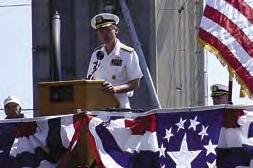
U.S. Navy photo
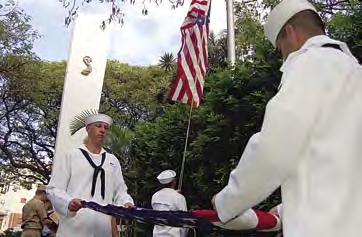
(above) Rear Adm. Jeffrey Cassias addresses USS Lagarto family members from the deck of USS Cobia (SS-245), a restored World War II submarine moored next to the Wisconsin Maritime Museum.
(left) Sailors raise U.S. flags over the World War II Submarine Memorial at Pearl Harbor, Hawaii, that were presented to USS Lagarto family members during a memorial service held on May 6 at the Wisconsin Maritime Museum in Manitowoc.
Submariners Honored as Sea, Shore Sailors of the Year
by U.S. Fleet Forces Command Public Affairs
Praised for their exceptional service, 10 top Sailors (five seabased and five shore-based) gathered at the Founders Inn in Virginia Beach recently as the winners were announced in the 2006 U.S. Fleet Forces Command Sea and Shore Sailor of the Year competition.
Setting the tone for the evening, Commander, U.S. Fleet Forces Command, Adm. John B. Nathman said, “Tonight is not a night for speeches but for speaking straight from the heart about our Sailors.”
Amid a prestigious crowd of Navy leaders, supporters, and past Sailors of the Year, Petty Officer 1st Class (SS/SW/AW/DV) Jordan Rosadorosario and Petty Officer 1st Class (SW) Earl Watson, III, were named the 2006 U.S. Fleet Forces Command Sea and Shore Sailors of the Year respectively. Rosadorosario is currently serving on USS Seawolf (SSN-21) in Groton, Conn., and Watson is assigned to Commanding Officer, Naval Submarine Support Center, Kings Bay, Ga.
Allowing the top Sailors to savor the moment, Master of Ceremonies, U.S. Fleet Forces Command Fleet Master Chief Jon Thompson announced the winners with descriptive anecdotes about the Sailors before announcing their names.
“I heard him talk about an evaluation,” said Rosadorosario, who will be meritoriously advanced to the rank of Chief Petty Officer. “And I thought, ‘Hey, that’s my eval.’ I couldn’t believe it, it could have been any of the five of us.” His father and mother traveled from New Mexico to attend the banquet, and his father was much more certain about his son’s success, hugging him and saying, “I knew it. I knew it.” The announcement came at the conclusion of a week of activities designed to honor all 10 candidates’ service. The week also included intense oral boards where the candidates faced some of the fleet’s top Master Chiefs. The candidates had to explain their
U.S. Navy photo.
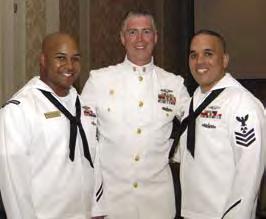
The Naval Submarine Force Master Chief, Master Chief Petty Officer (SS/SW) Dean Irwin (center), poses with the two Sailors selected as the 2006 U.S. Fleet Forces (CFFC) Sailors of the Year (SOY). CFFC’s Shore SOY is Petty Officer 1 st Class (SW) Earl Watson, III (left) from Naval Submarine Support Center, Kings Bay, Ga. CFFC’s Sea SOY is Petty Officer 1 st Class (SS/SW/AW/ DV) Jordan Rosadorosario (right) from USS Seawolf (SSN-21).
views on Navy programs and also share their thoughts on leadership and a variety of other topics.
“This whole week has been great. They really know how to make us feel special,” said Watson who will continue on to the Chief of Naval Operations Shore Sailor of the Year competition that will be held in Washington, D.C. in May.
SUBPAC Celebrates 106th Birthday of the Submarine Force

(From left to right) Rear Adm. Jeffrey Cassias, Commander Submarine Force U.S. Pacific Fleet, Seaman Storekeeper Nathaniel Price, Master Chief Electronics Technician Tim Butler, and COMSUBPAC’s Force Master Chief Michael Benko make the first cut of the 106th Enlisted Submarine Birthday Ball cake on April 21. Price and Butler represented the newest and the oldest submarine qualified active-duty members. Butler received his submarine dolphins in April 1982 and Price received his during the ceremony. The ball took place at the Hilton Hawaiian Village Hotel in Honolulu with more than 1,600 past and present submariners, their spouses, and friends.
Q&A: Undersea Dominance – A Submarine Force for the Future
continued from page 12
stand that he has a voice in the requirements process because he also works for Adm. Munns. Coordination across the pillars – the financial pillars, the shipyard pillars, the operational pillars – of the Undersea Enterprise impacts what we do here on a daily basis. There are several examples of capabilities that are in the fleet now because the Sailors on the boats asked for them. We have a well-organized, well-oiled machine working the problem. Our development squadron [Submarine Development Squadron 12] has a Submarine Tactical Requirements Group, a board of O-6s, that articulates the requirements they are seeing from the Fleet perspective twice a year. That requirements letter gets vetted through the two Type Commanders and then to me for action.
Q: What are you looking forward to as COMSUBPAC?
Most of my life I’ve been in operational jobs, so getting back into a command position is clearly something that I really do look forward to. I’ve had command of a ship, a squadron, and a group, so now to be a Type Commander is something I am eager to take on. It is especially exciting to be heading to the Pacific, where I think the world’s naval focus is centered today. Another aspect of the job is serving as the ASW Commander for Adm. [Gary] Roughead at COMPACFLT. Particularly with respect to open architecture, I think I can import the lessons learned in the Submarine Force and bring them to the surface Navy and the aviators – the Sailors operating SH-60s and P-3s. We really need to stop paying for the same things two and three times, and I’ve learned enough here to be able to shape that when I get out there.
SUBPAC is a real waterfront job. Even as the Group Commander in New London, you’ve got to get in a car to see a submarine; at SUBPAC, you look out your window, and you see four of them. Just seeing Sailors on a daily basis will be rewarding as well. I’ll never see many of the issues I’ve worked on in the Pentagon come to fruition, but when you’re out on the waterfront solving today’s problems, you get to see the impact you have in a much tighter feedback loop.
Q: Any parting thoughts?
I guess I would just say that I’ve enjoyed it here a lot more than I thought I would. Many Sailors dread coming to the Pentagon, and I think that’s the case for a lot of guys. But the camaraderie I’ve had with the other resource sponsors in the building has been more than I anticipated. The process is frustrating, but it works. I think we’ve had some outstanding leadership. Having the opportunity to work for two CNOs has shown me two different, but effective, leadership styles. I’ll look back on these two years as a very positive time. The mentoring I’ve received from Vice Adm. Munns, Adm. [Kirk] Donald [Director, Naval Nuclear Propulsion] and Adm. [Skip] Bowman before him has been tremendous. I think I’ve grown professionally in this job more than I have in most others. Overall, I’ve had a great experience and wouldn’t trade it for anything.
Mr. Smith is the Managing Editor of UNDERSEA WARFARE Magazine and an analyst with Alion Science and Technology in Washington, D.C.
Kuroshio Makes U.S. Port Call
Photo by JO1(SW) Cynthia Clark
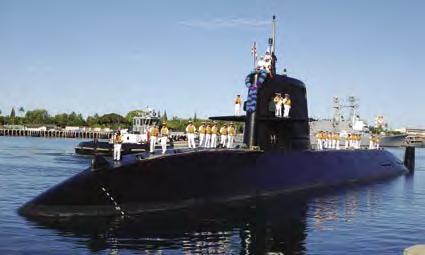
Japan Maritime Self-Defense Force submarine Kuroshio enters Naval Station Pearl Harbor on June 25, 2006. Commander, Submarine Squadron ONE hosted the submarine during their stay as part of RIMPAC 2006.
Photo by JO2 Corwin Colbert
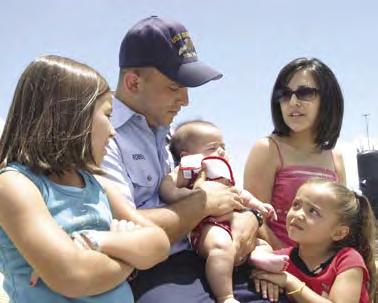
(above) The Republic of Korea Navy Submarine Jung Woon (SS-067) prepares to moor at the submarine piers at Naval Station Pearl Harbor on May 24 for this year’s Rim of the Pacific Exercise (RIMPAC). Jung Woon is the first for eign submarine to enter Pearl Harbor for this year’s exercise, which is held every two years. During RIMPAC 2004, more than 18,000 person nel onboard submarines and surface ships from the United States, United Kingdom, Canada, Australia, Japan, South Korea and Chile took part in the exercise.
Photo by JO2 Corwin Colbert
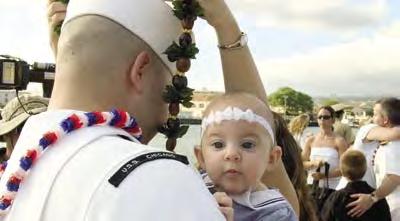
(above) Friends and loved ones said aloha to the submariners of USS Buffalo (SSN-715) as the Pearl Harbor-based nuclear-powered attack submarine departed for the Western Pacific June 12. This is the last time the submarine will depart Pearl Harbor for a deployment as it is slated to move to Guam next summer where it will become an asset of Submarine Squadron FIFTEEN.
(left) USS Chicago (SSN-721) submariner Petty Officer 1st Class John Cahill receives a lei from his wife and four-month-old daughter upon his return from deployment. The submarine returned to its homeport of Pearl Harbor May 30 following a six-month deployment to the Western Pacific. The Pearl Harbor-based submarine successfully con ducted missions vital to national security. The crew also visited several ports including Hong Kong, Japan, Singapore, and Guam.
On The Back
USS Pogy (SSN-647) is seen here surfaced in the Arctic. During SCICEX-96 (Scientific Ice Expeditions 1996), Pogy surfaced multiple times in the Arctic to collect water samples. Pogy was commissioned in May of 1971 and was decommissioned in January 1999.
Robert Malin, a self-taught artist with no formal training, was born in Tauranga, New Zealand to an American father and British mother. Mr. Malin enlisted in the Navy one week after coming to the United States in 1993. His previous assignments include USS Frank Cable (AS-40), USS Detroit (AOE-4), and Naval Submarine Base Kings Bay.









